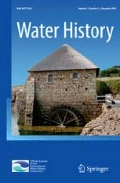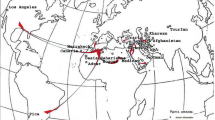Abstract
Since the 1990s, several archaeological teams have been investigating the link between Iron Age settlements in the Oman Peninsula and qanat systems. It is assumed that the development of water-draining galleries, such as qanat, or falaj as they are called in Oman, allowed for the settlement of populations on the desert fringes and the growth of villages at this time. Fieldwork undertaken by a Spanish archaeological team working at al Madam has provided evidence for the existence of wells and water-draining galleries (falaj/aflāj) in contemporaneous use at the beginning of First Millennium BC. The excavation of an underground gallery, the course of which forms a zig-zag pattern, has revealed a system that would have permitted the collection of a significant amount of groundwater. This proves the existence in Antiquity of a large shallow water table in the area of al Madam. The water that was brought to the surface by this system was diverted into secondary channels, tree-pits, ponds and pools, corresponding to the ancient cultivated fields. This unprecedented network of irrigation channels was dug into the natural rock. The archaeological record of al Madam shows that this cultivated area was situated to the east of the village in the Iron Age, and included a palm grove of significant size (at least 15 ha).











Similar content being viewed by others
Notes
Serjeant (1988), p. 152.
Aguirre (1775).
Various authors (2000), p. 102.
Schreiber (2001).
al Tikriti (2011), pp. 86–101.
Forman (1996), pp. 140–142.
Oman Iron Age chronology was agreed and accepted in 1997 after meeting at the office of the CNRS at Lyon: Iron Age I, 1300–1100 B.C.; Iron Age II, 1100–600 B.C.; Iron Age III, 600–300 B.C.
Córdoba and del Cerro (2005), pp. 515–532.
Mouton (1990–1992), pp. 3–10, Benoist (1997), pp. 59–74.
Córdoba (2016), p. 135.
del Cerro (2012), pp. 133–139.
del Cerro and Córdoba (2012), pp. 165–155.
Córdoba (2013), pp. 139–151.
Morales and Llorente-Rodríguez (2016), pp. 141–142.
We wish to thank the University of Tübingen and specially H.P. Ürpmann and B. Kromer for providing us the results of this dating.
References
Aguirre D (1775) Topografía del Real Sitio de Aranjuez, Madrid
al Tikriti WY (2011) Archaeology of the falaj. A Field Study of the Ancient Irrigation Systems of the United Arab Emirates. Department of Historic Environment, Abu Dhabi
Beaumont P et al (1989) Qanat, kariz and khattara. 1. Middle East. Underground water supply systems. School of Oriental and African Studies 19. London
Benoist A (1997) The Iron Age in al-Madam (Sharjah, UAE): some notes on the three seasons of work. PSAS 27:59–74
Boucharlat R (2003) Iron Age water-draining galleries and the Iranian « Qanāt » . In: Potts DT et al (eds) Archaeology of the United Arab Emirates proceedings of the first international conference on the archaeology of the UAE, UAE Motivate Publishing, Abu Dhabi, pp 162–172
Boucharlat R (2017a) Ancient qanāt and falaj, polycentric and multi period innovations: Iran and the United Arab Emirates as case-studies. In: Angelakis AN, Chiotis ED, Eslamian S, Weingartner H (eds) Underground Aqueducts Handbook. CRC Press, Boca Raton, pp 279–301
Boucharlat R (2017b) Irrigation in Southern Iran in the Early 1st mill. AD. Some hypotheses about draining galleries. In: al-Tikriti WY, Yule PA (eds) Proceedings of water and life in Arabia conference 14th–16th December 2014, Abu Dhabi Tourism and Culture Authority, Cultural Sector, Historic Department Abu Dhabi, pp 137–150
Córdoba JM (2003) Villages of shepherds in the Iron Age. The evidence of Al Madam. In: Potts DT et al (ed) Archaeology of the United Arab Emirates proceedings of the first international conference on the archaeology of the UAE, UAE Motivate Publishing, Abu Dhabi, pp 173–180
Córdoba JM (2013) New perspectives about Iron Age and the oasis culture in the Oman Peninsula. Two conclusive seasons at al Madam (Sharjah, UAE). Isimu 16:139–151
Córdoba JM (2016) Una misión española en Sharjah: en el corazón de Magán. De la tierra y el agua. In: Córdoba JM (ed) En los confines del Oriente Próximo. El hallazgo moderno del País de Magán. UAM ediciones, Madrid, pp 132–151
Córdoba JM, del Cerro C (2005) Archéologie de l’eau dans al Madam (Sharjah, Emirats Arabes Unies). Puits, aflaj et sécheresse pendant l’âge du Fer. Iranica Antiqua XL: 515–532
Córdoba JM, Mañé M (2000) Spazio architettonico e società in al-Madam (Sharjah, EAU) durante l’Età del Ferro. In: Matthiae P et al (ed) Proceeding of the Ist ICAANE, Università degli Studi di Roma “La Sapienza”, Roma, pp 251–265
Costa P (1984) Notes on settlement patters in traditional oman. JOS 6(2):247–268
de Cardi B (1984) Survey in Ras al-Khaimah, U.A.E. In: Boucharlat R (ed) Arabie Orientale, Mésopotamie et Iran Méridional de l’Age du Fer au début de la période islamique. Éditions Recherche sur les civilisations, Pari, pp 201–215
de Cardi B, Kennet D, Stocks RL (1994) Five thousand years of settlement al Khatt, UAE. PSAS 24:35–95
del Cerro C (2012) Some evidence of crisis and abandonment at the end of the Iron Age in Al Madam 1-Thuqaibah (Sharjah, UAE). In: Potts DT, Hellyer P (eds) Fifty years of Emirates Archaoelogy—proceedings of the second international conference on the archaeology of the United Arab Emirates, Ministry of Culture, Youth and Community Development, Abu Dhabi, pp 133–139
del Cerro C, Córdoba JM (2012) Canales y acequias, balsas de amasado y adobes durante la Edad del Hierro. Una campaña de excavaciones (2011) en al Madam (Sharjah, Emiratos Árabes Unidos). In: Argerich I (ed) Serie digital del IPCE, Informes y trabajos no 9: Excavaciones en el exterior 2011, Ministerio de Cultura, Madrid, pp 163–177
Forman W (1996) Phoenix rising. The United Arab Emirates. Past, present and future. The Harvill Press, London
Goblot H (1979) Les Qanats, une technique d’acquisition de l’eau. Mouton, Paris
Jasim SA, Uerpmann M, Uerpmann H-P (2016) Mleiha. The unwritten history. Medina Publishing, Surbiton
Lombard P (1991) Du rythme naturel au rythme human: vie et mort d’une technique traditionnelle, le qanāt”. In: Cauvin M (ed) Rites et rythmes agraires, TMO 20, GDR-Maison de l’Orient, Lyon, pp 68–86
Magee P (2000) Patterns of settlement in the Southeast Arabian Iron Age. Adumatu 1:29–39
Mañé M (2005) Hallado un incensario en Thuqaibah (Sharjah, Emiratos Árabes Unidos). Interpretaciones de uan forma singular en determinadas estructuras de la Edad del HIerro. Isimu 8:253–270
Mershen B (1998) Settlement space and architecture in South Arabian oases-ethnoarchaeological investigations in recently abandoned settlement quarters in inner Oman. PSAS 28:201–213
Morales A, Llorente-Rodríguez L (2016) Moluscos en las acequias. In: Córdoba JM (ed) En los confines del Oriente Próximo. El hallazgo moderno del País de Magán. UAM ediciones, Madrid, pp 141–142
Mouton M (1990–1992) Archaeological survey of the region of al-Madam. Preliminary results 1992. In: Boucharlat R (ed) Archaeological surveys and excavations in the Sharjah Emirate, 1990–1992. A sixth interim report, GDR-Maison de l’Orient, Lyon, pp 3–10
Nasif AA (1980) Qanats at al ‘Ula. PSAS 10:75–80
Nasif AA (1987) An ancient water system in Sakārā, al jaef, Saudi Arabia. PSAS 10:127–135
Schreiber J (2001) Maysar 42 & 43 (Sultanato de Omán). In: Mouton M, al Tikriti WY (eds) DAA 2, The architectural remains of the Iron Age sites in the United Arab Emirates and Oman. Maison de l’Orient, Lyon/Department of Antiquities and Tourism of al-Ain (Abu Dhabi)
Serjeant RB (1988) Observations on irrigation in South West Arabia. PSAS 18:145–153
Various Authors (2000) Omán 2000. Treinta años de entrega. Ed. Ministerio de Información, Mascate
Wilkinson JC (1997) Water and tribal settlement in South-East Arabia. A study of the Aflaj Oman. Clarendon Press, Oxford
Author information
Authors and Affiliations
Corresponding author
Rights and permissions
About this article
Cite this article
del Cerro, C., Córdoba, J.M. Archaeology of a falaj in al Madam Plain (Sharjah, UAE); a study from the site. Water Hist 10, 85–98 (2018). https://doi.org/10.1007/s12685-018-0210-0
Received:
Accepted:
Published:
Issue Date:
DOI: https://doi.org/10.1007/s12685-018-0210-0




